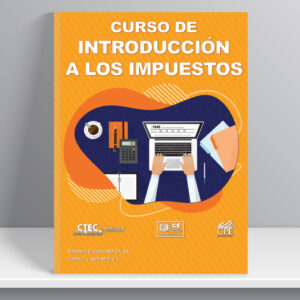The CTEC 20 Hour Continuing Education renewal course fulfills the 20-hour CTEC requirement for CRTPs who have already completed 60 hours of Qualifying Education. California residents must provide an active PTIN, maintain a $5,000 tax preparer insurance bond, and complete 20 hours of CE by October 31st each year to renew their registration with CTEC.
CTEC 20 Hour Continuing Education
THIS COURSE MUST BE COMPLETED BY OCTOBER 31ST TO BE REPORTED TO CTEC BEFORE THE DEADLINE.
This course is divided into four parts: Ethics, Federal Tax Law, Updates, and California Tax Law. Each part contains a final; the final must be passed with a 70% or higher before advancing to the next part.
$125.73
Description
Chapters
Chapters
Part 1 Ethics
Ethics
This chapter will explain how to determine who qualifies as a tax return preparer, what representation rights a preparer has, how that individual is bound by the Circular 230 guidelines, and what it means for a tax preparer to behave ethically and responsibly.
Part 2 Federal Tax Law
Income
The IRS has the authority to tax all income from whatever source it is derived. This includes compensation for services, gains from dispositions of property, interest and dividends, rent and royalties, pensions and annuities, gambling winnings, and even illegal activities. All such income a person receives is collectively referred to as “worldwide income.” However, not all money or property is taxable or subject to tax. This chapter will cover the different types of taxable and nontaxable income and show you where and how to report such wages on a professionally prepared tax return. A tax professional must recognize the different kinds of taxable income, tax-exempt income, and other income included in Schedule 1, line 21, and must know how to figure out the taxable percentage on Social Security benefits.
Tax Credits and Payments
A nonrefundable tax credit reduces the amount of tax liability that may have to be paid. Unlike a deduction, which reduces the amount of income that is subject to taxation, a credit directly reduces the tax itself. There are two types of credits: nonrefundable, which cannot reduce tax liability below zero, and refundable, which can reduce tax liability below zero, resulting in the need for a refund.
Other Taxes and Taxpayer Penalties
This chapter provides an overview of miscellaneous taxes from the Form 1040 and reported on Schedule 2 that a taxpayer might be assessed. This includes excess Social Security tax, additional taxes on IRAs, the Alternative Minimum Tax, and household employment taxes.
Business Income
This chapter presents an overview of Schedule C, which includes income and expenses. The income or loss is reported on Form 1040, Schedule 1, line 3. Sole proprietorship is not a legal entity; it refers to a person who owns a business and is personally responsible for its debts. Sole proprietorship is a popular business structure due to the simplicity, ease of setup, and nominal startup costs. Ultimately, a sole proprietor would register the business name with the state and city, obtain local business licenses, and then open for business. A drawback of being a sole proprietor is that the owner is 100% personally liable for the business’s income and/or debt.
Offer in Compromise
An Offer in Compromise (OIC) is an agreement between a taxpayer and the Internal Revenue Service (IRS) that allows the taxpayer to settle their tax debt for less than the full amount that they owe. It may be a legitimate option if the taxpayer cannot pay their full tax liability or if trying to pay the tax liability creates a financial hardship for the taxpayer. The IRS will consider everyone’s unique set of facts and circumstances including their ability to pay, their income and expenses, and their asset equity. There is a pre-qualifier online interview on the IRS website that taxpayers can take to see if they are eligible for an OIC.
Part 3 Updates
2021/2022 Tax Updates
This course covers the 2021/2022 annual inflation adjustments of standard deductions, tax rates, and refundable and nonrefundable credits. This course will have information on how the pandemic has changed tax season and other important events. Learn the latest changes on the regulations regarding qualified business income (QBI) and changes. Changes to Form 1040 and the schedules will be discussed and so much more. Additional topics include:
- ARPA
- CARES Act
- SECURE Act
- Families First Coronavirus Act
- Annual Inflation Adjustments
- Disaster relief changes
Part 4 California Tax Law
Compiling Taxpayers Information
The California tax return does not follow the federal return line-by-line, as established by the following:
- California subtracts the exemption amount from the tax owed.
- California did not conform to the TCJA with respect to not being able to claim an exemption for dependents.
- California begins by gathering the taxpayer’s and spouse’s personal information.
- If the couple’s status is a registered domestic partner (RDP) or same sex married couple (SSMC), you will enter the spouse’s information on Form 540.
The information needed to complete the state return is:
- First and last name as found on SSN or ITIN.
- Address (including city, state, and zip).
- Date of birth.
- Prior name (if the taxpayer or spouse filed a prior California return with a different last name).
California does not conform to most of the federal Tax Cuts and Jobs Act changes. A tax practitioner needs to understand state tax law to make sure that the taxpayer is receiving all the credits and paying the correct amount of tax.
Income
Although California does not conform to certain provisions of the Internal Revenue Code, it does conform in the following ways:
- The “general rule.”
- The “simplified general rule,” or the “safe harbor method.”
- IRA rollovers.
- Roth IRAs.
- Archer MSAs.
- Coverdell ESAs.
- Current-year IRA deductions.
- Lump-sum credits received by federal employees.
Tax Credits and Payments
Although a variety of California tax credits are available to help the taxpayer reduce their tax liability, California does not conform to all the credits that can be claimed on the federal return. This chapter will cover FTB Form 540, lines 40-48. California refers to this section as “Special Credits”. A tax preparer is responsible for ensuring (to the best of his or her knowledge) that the taxpayer is filing a true and accurate return by asking the client detailed questions and doing as much research as necessary.
Other Taxes and Taxpayer Penalties
The Franchise Tax Board (FTB) is the agency responsible for collecting state personal income taxes in California. The revenues FTB collects are placed in the state’s general fund to help pay for items, such as roads, parks, law enforcement, and schools. California’s state income tax system is based on the principle of voluntary compliance. Voluntary compliance is a system of taxation that relies on individual citizens to properly report their income, calculate their tax liability, and file their tax returns timely.
State personal income tax, like federal income tax, is a tax imposed on wages, tips, interest, dividends, pensions, capital gains, and other types of income. First imposed in 1936, state personal income tax is the largest single source of revenue in California. Personal income tax is based on the amount of taxable income that people receive annually. Taxable income is less than total income, due to tax deductions.
This lesson is a brief overview of other California taxes that a taxpayer might pay as well as the types of penalties a taxpayer may pay and why.
Course Details
Course Details
| Course Details:
COURSE NAME: 2024 California 20 Hour Continuing Education COURSE LEVEL: Intermediate ADVANCED PREPARATION: This course is for CRTPs who have already completed 60 hours of qualifying education DELIVERY METHOD: Self-Study CTEC VENDOR: #2080 CTEC COURSE: 2080-CA-0006 EXPIRATION: Per CTEC regulations, this course expires January 15 |
Included in this course:
|
To Complete this Course & Receive Credit, you must…
|
|
Renewing
Renewing
To renew your registration all CRTPs must…
|






